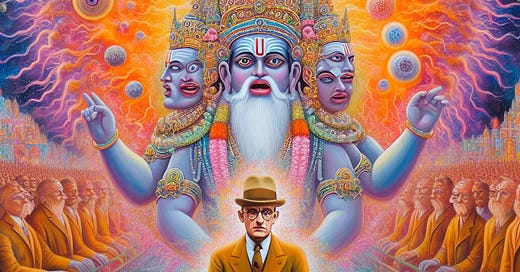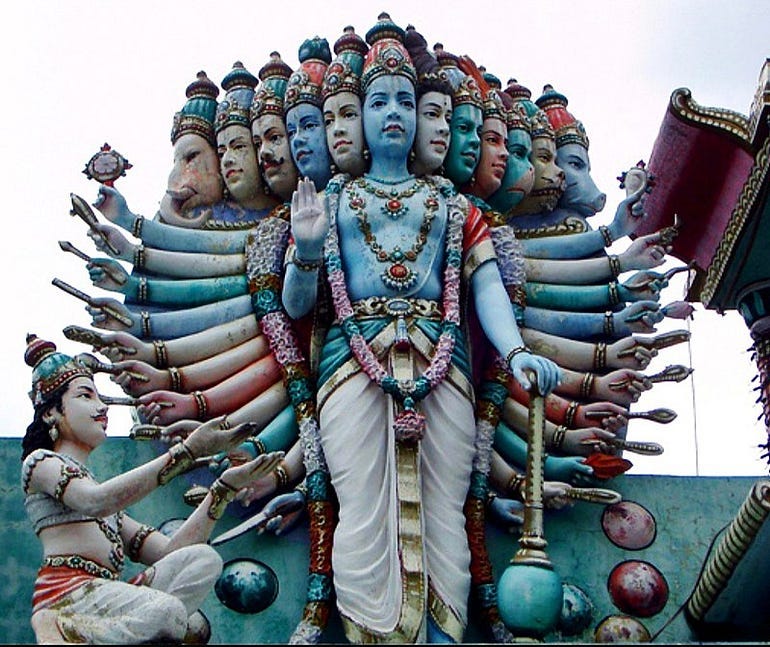“Now I am become Death”: Oppenheimer’s Tragic Misreading of the Bhagavad Gita.
How the architect of the A-bomb missed the Scripture’s spiritual message.
📢 **Exciting News: Elevate Your Experience with Premium Benefits!**
Now, I'm thrilled to unveil an exciting development—we're introducing premium paid subscriptions to Vedanta Substack! By becoming a paid subscriber, you not only enhance your experience but also play a crucial role in supporting the continuation of our exploration.
Vedanta Substack is a reader-supported publication. To receive new posts and support my work, consider becoming a free or paid subscriber.
🔓 **Unlock Exclusive Benefits as a Paid Subscriber**
As a paid subscriber, you'll enjoy a range of exclusive benefits:
- Access to in-depth posts with special recommendations for further study.
- Personal invitations to exclusive chats or podcast interviews on captivating topics, featuring multiple thinkers simultaneously.
- The opportunity to propose the publication of your articles and essays on Vedanta Substack.
- Invitations to Vedanta retreats and events offering a deeper exploration of spiritual and philosophical realms.
Image by Author
As an admirer of Indian philosophy and scientific history, I am fascinated by physicist J. Robert Oppenheimer, head of the Manhattan Project who developed the first atomic weapons. Oppenheimer read the Gita in Sanskrit and was deeply influenced by it. He often quoted it about his role in developing the atomic bombs that altered the course of World War II. Two days before the first nuclear test explosion in 1945, Oppenheimer recited his translation of a verse from chapter 11:
“In battle, in the forest, on the precipice in the mountains, on the dark great sea, amid javelins and arrows, in sleep, in confusion, in the depths of shame, the good deeds a man has done before defend him.”
(Bhagavad Gita, 11.36)
However, his famous quote upon witnessing the inaugural 1945 Trinity atomic test, “Now I am become Death, the destroyer of worlds,” reflects a superficial appreciation of Gita’s profound message. The Gita records the dialogue between Prince Arjuna and Lord Krishna — appearing as Arjuna’s charioteer — on the Kurukshetra battlefield. With the war against his kinsmen looming, a morally conflicted Arjuna asks Krishna which path of action to take. Over 18 chapters, Krishna expounds that the path of action with detachment, adhering to sacred duty and honour for its own sake without regard for personal reward or consequence, represents the highest moral good.
J. Robert Oppenheimer in 1944.
To convince Arjuna of this teaching and reveal His divine cosmic form, Krishna manifests the spectacular “Vishvarupa” with infinite arms and mouths spanning all of perceptible existence. When Krishna shows Arjuna His awe-inspiring cosmic form with infinitely extending arms and mouths, displaying the entire universe with all its facets in one visage, Arjuna recoils in fear. Viewing the terrifying Vishvarupa, embodying both creation and destruction, Arjuna says (chapter 11, verse 46):
“Seeing Your mouths terrible with tusks blazing like the fires at the end of time, I know not the directions nor find peace. Have mercy, Lord of gods, Abode of the universe.”
Yet after explaining that all creatures enter into His limitless body at the hour of their death while He generates new life continuously, Krishna urges Arjuna not to be frightened. As the embodiment of indestructible cosmic time governing the cycle of Creation, Krishna destroys only to recreate. Destruction thus leads paradoxically to renewal. Krishna says (chapter 11, verses 50–55):
“You are without beginning, middle or end; infinite in power with innumerable arms. The sun and moon are Your eyes, and when Your face, burning with sacrificial fire, scorches the universe, who could bear it but You? O Lord of celestial rulers, sole Refuge of the universe, be gracious! Show me Yourself just as before. I want to see You as the friendly human being that I know. You who are the first cause of the universe, infinite in form and the true Abode of all sages — please appear again as before!” The Lord then says consolingly: “Out of grace for you, Arjuna, through My power of yoga I have shown this supreme form, brilliant, infinite and primal, which no one but you has seen before.”
So the Vishvarupa symbolizes the limitless potential for both creation and destruction — the beginning and end of all things in the universe simultaneously, encompassed in Krishna’s cosmic body. For an individual mortal to declare “I am become Death” would be paradoxical and presumptuous. Oppenheimer fails to understand that in the Gita, Death is subordinate to indestructible cosmic Time (=Krishna) governing the endless cycle of worldly existence. No mortal truly “becomes” Death, the annihilator. Awestruck at the sight encompassing wrath and comfort, terror and succour, the finite and infinite, Arjuna begs Krishna to resume His familiar guise as companion and counsel. Krishna explains that all creatures merge into His boundless form when they die, as He perpetually recreates new life.
A fortiori when we consider the concept of Maya, the veil of illusion surrounding mundane reality, Oppenheimer's interpretation appears limited. Krishna reveals to Arjuna the deeper truth that his divine form encompasses all mortal frames of reference, transcending yet underlying the world of name and form. What seems like death and destruction from the human vantage point constitutes but a passing phase in the endless cycles of cosmic renewal over which Krishna presides. Oppenheimer grasps at fragments of this mystical vision without fully attaining its integrative wisdom. Lacking insight into Maya's veiling power, he projects the disjunctive mindset born of proliferating nuclear weaponry onto the Bhagavad Gita's cosmic revelation. A more holistic reading illuminates why Arjuna responds not with despair at evanescence but joy upon discovering his eternal essence in Krishna's all-embracing being.
Singapore. Statue of Krishna as Vishnu in his Vishwarupa (Universal form). Photo by Steve Jurvetson.
Embodying indestructible cosmic time governing the wheel of creation, preservation, death and rebirth, Krishna’s destruction paradoxically enables existence and renewal.
Chapter 11 further illuminates the concept of detached action for a greater purpose through an extended monition from Krishna to Arjuna. Here Krishna articulates the idea underpinning and reconciling His exaltations of honourable action with His displays of destructive power:
“I am mighty world-destroying Time, here made manifest to infold the world forcefully. Even without you, none of the warriors arrayed in hostile ranks shall live…Therefore arise and attain fame! Conquer your enemies and enjoy opulent kingship! Verily by Myself have they already been slain; be merely the instrument, Arjuna…Slay Drona, Bhishma, Jayadratha and Karna along with other valorous warriors, who have already been killed by Me…Fight! Let not your will be unstrung through delusion in this decisive moment.”
This passage crystallizes the message Arjuna — and by extension Oppenheimer himself — fatally disregarded. Krishna does not exhort senseless violence for egotistic victory. Rather, He calls for action aligned with and serving cosmic order for the greater moral purpose — carried out mindfully without personal investment in limited material outcomes of success or failure, killing or being killed. Krishna has already orchestrated the war’s conclusion; Arjuna and the Manhattan Project physicists are mere vectors channelling destiny’s pre-written culmination. Their duty is spiritual abidance to lawful harmony, not base destruction of people and cities out of primal fear and egoism.
With Gita’s lessons in perspective, Oppenheimer’s post-Trinity bomb quotation, “Now I am become Death, destroyer of worlds,” signals profound misconception. No singular mortal can declare “I am Death” when scripture includes everything, everyone and temporality itself into eternal cosmological order embodied in Krishna.
Oppenheimer focuses on the "Destroyer of Worlds" idea after the first atomic bomb test at Trinity in Los Alamos. This test paved the way for the bombings of Hiroshima and Nagasaki in 1945. But he interprets these words too simply. Krishna's divine vision includes all of the cosmic realms that are always dissolving and re-forming in cycles across time - far vaster scales of existence than humans can understand. While the atomic bombs caused unbelievable devastation that people had not seen before in the 20th-century world, their impacts were tiny compared to the infinite worlds always dying and rebirthing under Krishna's gaze. Unable to grasp this big-picture framework, Oppenheimer projects the narrow mindset of nuclear weapons onto the Bhagavad Gita's universal revelation. The "Death of Worlds" in that text refers not to one civilization's destructive technology, but the eternal process by which Krishna destroys and restores all created things across the past, present and future.
To sum up, Oppenheimer’s quote exposes his superficial Gita interpretation. Enraptured by the godly power of absolute destruction, he overlooked Krishna’s ultimate message — to carry out actions mindfully without egoistic craving or aversion to their results when they neither increase nor decrease the indivisible soul. Ironically Oppenheimer enacted the very opposite by creating weapons of mass civilian carnage fueled by delusion, fear and hubris. Neither comprehending non-attached action nor cosmic time’s perpetual regeneration, his chest-thumping “Destroyer” utterance proves paradoxically ignorant in the face of the Gita’s transcendental truths.
I have woven tales to share, for any who care to read them. My books await you on Google Books. Check also my stories on Medium.com.
I would be honoured if you considered subscribing to the Premium Contents of my Vedanta Substack and leaving feedback, comments, and suggestions both on this page and by writing to me at cosmicdancerpodcast@gmail.com.
Thank you for your precious attention.






